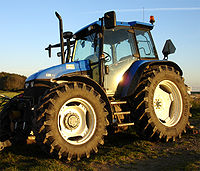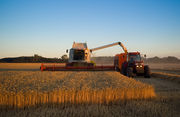Agricultural engineering

Agricultural engineering is the engineering discipline that applies engineering science and technology to agricultural production and processing. Agricultural engineering combines the disciplines of animal biology, plant biology, and mechanical, civil and chemical engineering principles with a knowledge of agricultural principles. It involves a broader scope engineering in all the world than any other engineering discipline. It utilizes the knowledge of engineering for making agricultural machinery.[1]
Contents |
Subfields

Some of the specialties of agricultural engineers include:[1][2]
- the design of agricultural machinery, equipment, and agricultural structures
- crop production, including seeding, tillage, irrigation and the conservation of soil and water
- animal production, including the care and processing of poultry and fish and dairy management
- the processing of food and other agricultural and biorenewable products,and food engineering.
- Bioresource engineering, which uses machines on the molecular level to help the environment.

History
The first curriculum in Agricultural Engineering was established at Iowa State University by J. B. Davidson in 1905. The American Society of Agricultural Engineers, now known as the American Society of Agricultural and Biological Engineers, was founded in 1907.[3]

Agricultural engineers
Agricultural Engineers may perform tasks as planning, supervising and managing the building of dairy effluent schemes, irrigation, drainage, flood and water control systems, perform environmental impact assessments, agricultural product processing and interpret research results and implement relevant practices. A large percentage of agricultural engineers work in academia or for government agencies such as the United States Department of Agriculture or state agricultural extension services. Some are consultants, employed by private engineering firms, while others work in industry, for manufacturers of agricultural machinery, equipment, processing technology, and structures for housing livestock and storing crops. Agricultural engineers work in production, sales, management, research and development, or applied science.
See also
- Mechanized agriculture
- Industrial agriculture
- List of agricultural machinery
- Bioresource engineering
References
- ↑ 1.0 1.1 Hills, David. (2004). "Agricultural engineering." in The Engineering Handbook (2nd ed). CRC Press. ISBN 0849315867. pp. 190-1 - 190-9.
- ↑ "Agricultural engineering." (2002). in The McGraw-Hill Encyclopedia of Science and Technology. 9th ed. McGraw Hill: New York. ISBN 0079136656. p.212-213.
- ↑ ASABE website. Accessed May 15, 2009.
Further reading
- Brown, R.H. (ed). (1988). CRC handbook of engineering in agriculture. Boca Raton, FL.: CRC Press. ISBN 0849338603.
- Field, H. L., Solie, J. B., & Roth, L. O. (2007). Introduction to agricultural engineering technology: a problem solving approach. New York: Springer. ISBN 0387369139.
- Stewart, Robert E. (1979). Seven decades that changed America: a history of the American Society of Agricultural Engineers, 1907-1977. St. Joseph, Mich.: ASAE. OCLC 5947727.
- DeForest, S. S. (2007). The vision that cut drugery from farming forever. St. Joseph, Mich.: ASAE. ISBN 1892769611.
External links
- Canadian Society for Bioengineering
- American Society of Agricultural and Biological Engineers Official Site
- International Academic Programs in Agricultural, Food,or Biological Engineering
- International Commission of Agricultural Engineering Official Site
- Department of Bioresource Engineering part of McGill University
|
||||||||||||||||||||||||||
| This agriculture article is a stub. You can help Wikipedia by expanding it. |